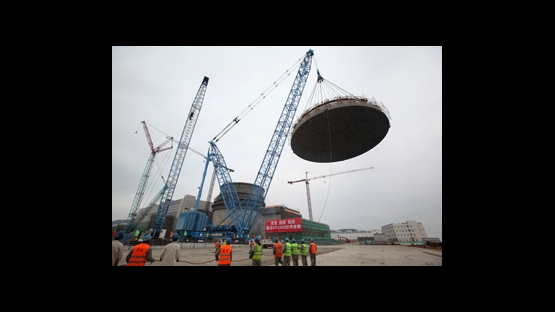The world's nuclear power generating capacity is projected to continue to grow by 2030, a recent IAEA study shows. The Agency's annual publication, entitled Energy, Electricity and Nuclear Power Estimates for the Period up to 2050 was released with analysis from the IAEA's energy planning experts.
Every year, the IAEA makes low and high projections of global nuclear power generating capacity: this year's low projection indicates 17 per cent growth in world total nuclear power capacity by 2030, while the high projection suggests a 94 per cent growth, i.e. nearly a doubling in global generation capacity. In other words, growth in nuclear power following the Fukushima Daiichi nuclear accident is expected to continue, however at a rate lower than estimated prior to the accident.
"The Agency's latest projections show continued growth in global use of nuclear power in the next 20 years, especially in Asia," said IAEA Director General Yukiya Amano in his opening statement to the 57th IAEA General Conference held in Vienna last week.
Challenges Remain
The annual projections made since 2011 have indicated that growth has slowed, but not reversed. The 2013 updates, taking into account developments through April 2013, reinforce this conclusion. Over the short term, the low price of natural gas and the promotion of renewable energy sources in some energy policies are expected to impact nuclear growth prospects in several regions of the developed world. These low natural gas prices are partly due to low demand as a result of macroeconomic conditions, as well as technological advances, notably with fracture techniques to extract shale gas. Moreover, the on-going financial crisis continues to present challenges for capital intensive projects such as nuclear power.
"Nuclear energy can be viewed as a critical component of a country's energy infrastructure, providing a clean and dependable long-term source of energy," says David Shropshire, Head of the IAEA's Planning and Economic Studies Section.
In the long run, nuclear generating capacity is expected to play an important role in the energy mix due to growth in population and in demand for electricity in the developing world, as well as climate change concerns, security of energy supply and price volatility for other fuels.
Challenges remain, and policy responses to the Fukushima Daiichi nuclear accident are still evolving. However, over the past year, most countries have finalized their nuclear safety reviews, providing greater clarity with respect to nuclear power development. The final result of those reviews, reactor safety modifications, and in some cases even reactor shut-downs, is that greater confidence in nuclear power is expected as a safe and secure energy source.
Regional Overview
In the 2013 updated low projection, the world's installed nuclear power capacity grows from 373 gigawatts (GW(e)) today to 435 GW(e) in 2030. In the updated high projection, it grows to 722 GW(e) in 2030 (A gigawatt, or GW(e), equals one billion watts of electrical power).
The strongest projected growth is in regions that already have operating nuclear power plants, led by Asian countries, including China and the Republic of Korea. From 83 GW(e) at the end of 2012, capacity grows to 147 GW(e) in 2030 in the low projection and to 268 GW(e) in the high projection.
Eastern Europe, which includes Russia, as well as the Middle East and South Asia, which includes India and Pakistan, also show strong growth potential. Nuclear capacities grows from 48 GW(e) in 2012, to 79 GW(e) and 124 GW(e) in the low and high cases, respectively.
Western Europe shows the biggest difference between the low and high projections. In the low projection, Western Europe's nuclear power capacity drops from 114 GW(e) at the end of 2012 to 68 GW(e) in 2030. In the high projection, nuclear power grows to 124 GW(e).
In North America, the low case projects a small decline, to 101 GW(e) in 2030, while the high projection shows an increase from 116 GW(e) at the end of 2012 to 143 GW(e), or a 24 per cent increase.
Key Assumptions
The low projection assumes current market, technology and resource trends continue with few additional changes in laws, policies and regulations affecting nuclear power. It does not assume that all national targets for nuclear power will be achieved. It is a "conservative but plausible" projection.
The high projection assumes that the current rates of economic and electricity demand growth will continue, notably in Asia. It also assumes changes in country policies toward the mitigation of climate change.
The low and high projections are developed by experts from around the world who meet each Spring at the IAEA. They make their projections by assessing each operating reactor, possible licence renewal, planned shutdown and plausible construction projects foreseen for the next several decades. The projections are made at a regional, rather than national, level.
For more information, see:
- Projections 2013
- Projections 2012
- Projections 2011
- Projections made in 2010, before the Fukushima accident


